The history of human habitation in Morocco spans since the Lower Paleolithic, with the earliest known being Jebel Irhoud. Much later Morocco was part of Iberomaurusian culture, including Taforalt. It dates from the establishment of Mauretania and other ancient Berber kingdoms, to the establishment of the Moroccan state by the Idrisid dynasty followed by other Islamic dynasties, through to the colonial and independence periods.

Haj Muhammad Ben Abdessalam al-Muqri was a senior Moroccan official of the late 19th and early 20th century. He was an adviser and grand vizier to several sultans of Morocco, including under French colonial domination.

The French protectorate in Morocco, also known as French Morocco, was the period of French colonial rule in Morocco between 1912 and 1956. The protectorate was officially established 30 March 1912, when Sultan Abd al-Hafid signed the Treaty of Fez, though the French military occupation of Morocco had begun with the invasion of Oujda and the bombardment of Casablanca in 1907.

MoulayAbd al-Rahman bin Hisham, born on 19 February 1778 in Fes and died on 28 August 1859 in Meknes, was a sultan of Morocco from 30 November 1822 to 28 August 1859, as a ruler of the 'Alawi dynasty. He was a son of Moulay Hisham. He was proclaimed sultan in Fes after the death of Moulay Sulayman.
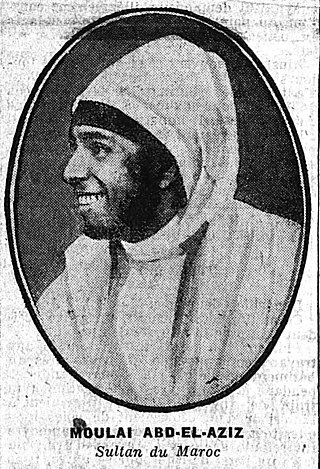
MoulayAbd al-Aziz bin Hassan, born on 24 February 1881 in Marrakesh and died on 10 June 1943 in Tangier, was a sultan of Morocco from 9 June 1894 to 21 August 1908, as a ruler of the 'Alawi dynasty. He was proclaimed sultan at the age of sixteen after the death of his father Hassan I. Moulay Abdelaziz tried to strengthen the central government by implementing a new tax on agriculture and livestock, a measure which was strongly opposed by sections of the society. This in turn led Abdelaziz to mortgage the customs revenues and to borrow heavily from the French, which was met with widespread revolt and a revolution that deposed him in 1908 in favor of his brother Abd al-Hafid.

Abd al-Hafid of Morocco or Moulay Abdelhafid was the Sultan of Morocco from 1908 to 1912 and a member of the Alaouite Dynasty. His younger brother, Abdelaziz of Morocco, preceded him. While Mulai Abdelhafid initially opposed his brother for giving some concessions to foreign powers, he himself became increasingly backed by the French and finally signed the protectorate treaty giving de facto control of the country to France.
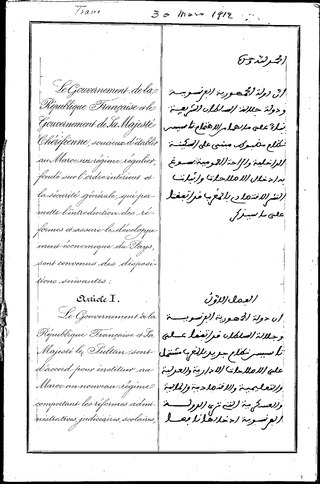
The Treaty of Fes, officially the Treaty Concluded Between France and Morocco on 30 March 1912, for the Organization of the French Protectorate in the Sherifien Empire, was a treaty signed by Sultan Abd al-Hafid of Morocco under duress and French diplomat Eugène Regnault on 30 March 1912. It established the French protectorate in Morocco, and remained in effect until the Franco-Moroccan Joint Declaration of 2 March 1956.
Sidi Mohammed ben Abdallahal-Khatib, known as Mohammed III, born in 1710 in Fes and died on 9 April 1790 in Meknes, was the Sultan of Morocco from 1757 to 1790 as a member of the 'Alawi dynasty. He was the governor of Marrakesh around 1750. He was also briefly sultan in 1748. He rebuilt many cities after the earthquake of 1755, including Mogador, Casablanca, and Rabat, and Abdallah Laroui described him as "the architect of modern Morocco." He also defeated the French in the Larache expedition in 1765 and expelled the Portuguese from Mazagan (al-Jadīda) in 1769. He is notable for having been the leader of one of the first nations to recognize American independence in his alliance with Luis de Unzaga 'le Conciliateur' through correspondence and Unzaga's secret intelligence service and led by his brothers-in-law Antonio and Matías de Gálvez from the Canary Islands. He was the son of Mawlay Abdallah bin Ismail and his wife a lady of the Chéraga guich tribe.
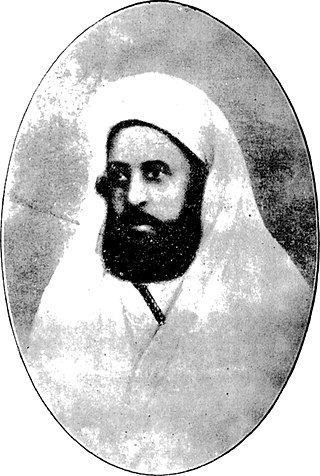
MawlayHassan bin Mohammed, known as Hassan I, born in 1836 in Fes and died on 9 June 1894 in Tadla, was a sultan of Morocco from 12 September 1873 to 7 June 1894, as a ruler of the 'Alawi dynasty. He was proclaimed sultan after the death of his father Mawlay Muhammad bin Abd al-Rahman. Mawlay Hassan was among the most successful sultans. He increased the power of the makhzen in Morocco and at a time when so much of the rest of Africa was falling under foreign control, he brought in military and administrative reforms to strengthen the regime within its own territory, and he carried out an active military and diplomatic program on the periphery. He died on 9 June 1894 and was succeeded by his son Abd al-Aziz.

Mohammed Ben Aarafa, or Ben Arafa, was a paternal first cousin once removed of Sultan Mohammed V of Morocco; he was put in Mohammed V's place by the French after they exiled Mohammed V to Madagascar in August 1953. His reign as "Mohammed VI" was not recognized in the Spanish-protected part of Morocco. Protests against Ben Aarafa helped lead to Moroccan independence, which was agreed to between France and Mohammed V, after his abdication in October 1955.
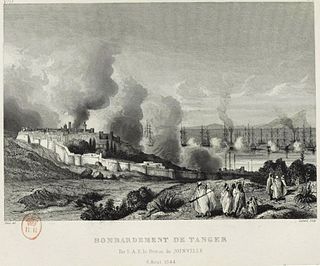
The Franco-Moroccan War was fought between the Kingdom of France and the Sultanate of Morocco from 6 August to 10 September 1844. The principal cause of war was the retreat of Algerian resistance leader Abd al-Kader into Morocco following French victories over many of his tribal supporters during the French conquest of Algeria and the refusal of the Sultan of Morocco Moulay Abd al-Rahman to abandon the cause of Abd al-Kader against colonial occupation.
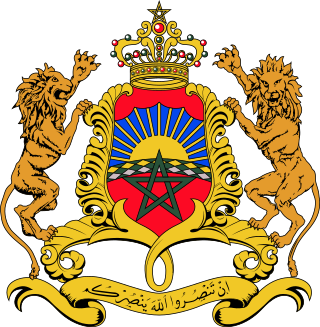
In Morocco, the 75 second-level administrative subdivisions are 13 prefectures and 62 provinces. They are subdivisions of the 12 regions of Morocco. Each prefecture or province is subdivided into arrondissements, municipalities or urban municipalities in other urban areas, and districts in rural areas. The districts are subdivided into rural municipalities. One prefecture (Casablanca) is also subdivided into préfectures d'arrondissements, similar to districts (cercles) except they are grouping a few arrondissements instead of rural municipalities.
Rail transport in Morocco was initially developed during the protectorate. It functioned primarily as a means to mobilize colonial troops and to transport natural resources. Later, a standard-gauge network was built.

France–Morocco relations are bilateral relations between Morocco and France. They are part of the France–Africa relations.
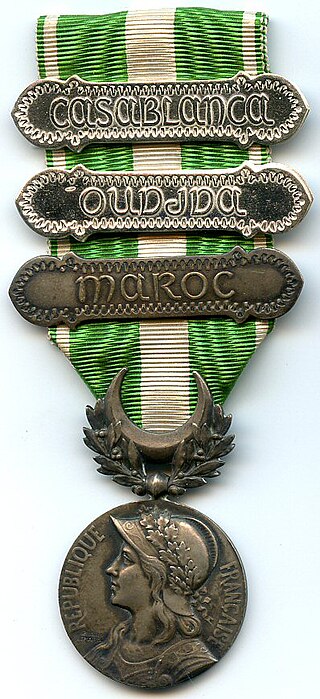
The Morocco commemorative medal (1909) was a French military campaign medal. It was established by the law of 22 July 1909 for award to soldiers participating in the Second Franco-Moroccan War under the command of general Hubert Lyautey.

The history of Marrakesh, a city in southern Morocco, stretches back nearly a thousand years. The country of Morocco itself is named after it.

The Battle of Sidi Bou Othman was an important battle fought at Sidi Bou Othman, some 40 kilometers north of Marrakesh, during the French conquest of Morocco. It saw the victory of a French column under Colonel Charles Mangin over the forces of the south Moroccan leader Ahmed al-Hiba in September 1912. As a result of the victory, the French captured the city of Marrakesh and annexed southern Morocco into the French protectorate of Morocco. The conquest was facilitated by the defection of the great qaids of the south, notably the El Glaoui brothers.

The Hafidiya was a coup d'état in Morocco between 1907 and 1908 in which Abd al-Hafid seized power from his brother Abdelaziz. Abd al-Hafid started his movement in Marrakesh in the aftermath of the Algeciras Conference, the French occupation of Oujda and of Casablanca and the gaining the support of Amazigh leaders in the south. The Ulama of Fes supported Abdelhafid only with an unprecedented Conditioned Bay'ah, or pledge of allegiance.
The Conditioned Bay'ah or the Bay'ah of Fes was a bay'ah contract of the conditional support of the people of Fes for Abd al-Hafid as sultan of Morocco in the Hafidiya. Led by the Sufi leader Muhammad al-Kattani, the people of Fes imposed, for the first time in Morocco, a set of conditions on the sovereign in return for their support.

The Abdelhafid Palace or Moulay Hafid Palace is a historic structure at 23, rue Mohammed Ben Abedelouhab in the Hasnouna neighborhood of Tangier, Morocco. It was built in 1912–1913 as the intended main residence of former Sultan Abdelhafid following his abdication, but was never used for that purpose. In 1927, it was purchased by Italy and subsequently renamed Palazzo Littorio, hosting various public institutions including schools and a hospital. In 1943 the Badoglio government had it renamed Casa d'Italia, and a few years later it became known as the Palace of the Italian Institutions. Even though it still houses various Italian-related activities and was renovated in the early 2000s, it has long remained underutilized.
























